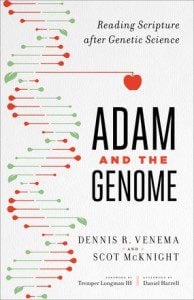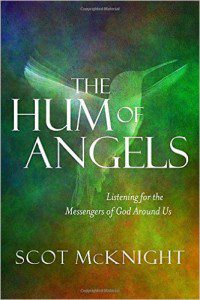A pastor-friend, Mark Stevens, is leading his congregation for a year in living the Jesus Creed. This is the banner they are using.
Jonathan Storment: “A few years ago I was talking with a man who was a professional conflict mediator who had worked with Presidents and international government officials. He had helped nations resolve international conflicts bordering on war, but if you asked him who was the hardest assignment, he wouldn’t blink an eye before he told you, “That’s easy…Churches” There’s a bizarre little story in the book of Joshua where Joshua is leading the people of Israel into the land of Canaan, and he is suddenly visited by an Angel of the LORD, and Joshua has such tunnel vision that he immediately asks the angel, “Are you for us or for our enemies?” And the angel says, “No. I’m not on either, as the Commander for the LORD I have come.” I love this little story, because it’s exactly what we religious people do.”
A powerful FB post by Carl Ruby. “In towns all across America streets are not named after them. School children do not learn about them. No one waits in line to see the homes where they were born. They are – “The Forgotten.” They weren’t necessarily bad men. They weren’t unimportant men. They were men of influence, men with a voice and the respect of their community. Most would have agreed; they were good men, according to one, “men of genuine good will.” While evil men are remembered and great men are enshrined, these men…. just forgotten. Forgotten for being on the wrong side of history. Men forgotten for being silent when “a word fitly spoken” could have made a difference. Men who are forgotten for valuing comfort and stability over justice and compassion. Forgotten because they were unwilling to call out the status quo, and show it for it was… cruel and unjust.”
A mom and a daughter, and some 3d grade boys: “I recognize that third grade boys are bad mirrors for the self-esteem of a young girl. So I called in better mirrors to weed out the mean words meant to marginalize. I wanted her to be seen truly and, maybe more importantly, to see herself truly.”
Kate Blanchard, at RD, has a good post on the SBNR: “Having hung out with church folk for several decades, I have come to expect the words “spiritual but not religious” to be accompanied by air quotes and a tone of disdain. But lately, even non-religious folk have begun to hate on the SBNR.”
Brother Ivo (HT: DR): “If ‘Bible-Believing’ were an inoculation against false doctrine, there would be no creeds! So, if Brother Ivo cavils at being associated with ‘Bible-Believing’, based upon its history of conflict and known frequency of error, to what does he cling in dark times of dispute? The answer lies in the nature, person and love of Christ, which shines in the darkness as a beacon of hope. Jesus’ own teaching style was rabbinic. He told stories, pointed the way and set an example. He never weighed his followers down with complexity, and he simplified what is required of us in terms that even a child could understand. The whole picture can be expressed by relatively little, and that is offered in a human life accessible to everyone. All that is needed is available through a living example of humility and love. So what might this ‘Christianity-for-the-rest-of-us’ call itself? If we are not to limit ourselves to being only ‘Bible believing’, to what should we aspire? Brother Ivo has a suggestion: ‘Gospel Gracious’.”
If you think this sentence is fun, go here: “This exceeding trifling witling, considering ranting criticizing concerning adopting fitting wording being exhibiting transcending learning, was displaying, notwithstanding ridiculing, surpassing boasting swelling reasoning, respecting correcting erring writing, and touching detecting deceiving arguing during debating.”
Ten typically mispronounced foods.
Good story of the week: “He started crying, obviously distraught. The flight attendants brought napkins for his tears, said they would do what they could to help, and most importantly, got his connecting flight information to the captain, he told CNN. When he got off the airport train and was running toward the gate, “I was still like maybe 20 yards away when I heard the gate agent say, ‘Mr. Drake, we’ve been expecting you,'” he said.”
Meanderings in the News
 Jeans on a 70s hitchhiker
Jeans on a 70s hitchhiker
Will they return the three I gave them?
Is your beer “skunky”? Read this. “I have a new beer rule. Avoid beer in green bottles. Just to be clear, this is a rule for myself. You can drink green bottled beer. In fact, you should always try to drink the beer that you like. For me, I will avoid the green bottles. Why? If you drink beer, you may know why. The the beer in these green bottles seem to have this extra taste that maybe is not so great. Someone (it was probably my biochemist beer brewing brother) told me that the green bottles don’t block ultraviolet light. It is a reaction with the ultraviolet light that causes this taste that I don’t like. Well, maybe I don’t always trust my brother (even though when it comes to beer, I should). You know what happens next, right? Experiment time.”
Pessimists, rejoice! “Worrying takes years off your life, right? Well, maybe not. Pessimists rejoice: happy-go-lucky, care-free peers of yours probably won’t live as long as you. New research suggests that the downers wind up outlasting the uppers. The American Psychological Association summarizes the research published in the journal Psychology and Aging, saying:
Older people who have low expectations for a satisfying future may be more likely to live longer, healthier lives than those who see brighter days ahead, according to new research published by the American Psychological Association.
“Our findings revealed that being overly optimistic in predicting a better future was associated with a greater risk of disability and death within the following decade,” said lead author Frieder R. Lang, PhD, of the University of Erlangen-Nuremberg in Germany. “Pessimism about the future may encourage people to live more carefully, taking health and safety precautions.”
From BBC News, on how to get along together — alone — for a long time: “The search is on for a couple to train as astronauts, for a privately funded mission to Mars. But wouldn’t any couple squabble if cooped up together for 18 months? Explorer Deborah Shapiro, who spent more than a year with her husband in the Antarctic, provides some marital survival tips. It never ceases to amaze us, but the most common question Rolf and I got after our winter-over, when we spent 15 months on the Antarctic Peninsula, nine of which were in total solitude, was: Why didn’t you two kill each other? We found the question odd and even comical at first, because the thought of killing each other had never crossed our minds. We’d answer glibly that because we relied on each other for survival, murder would be counter-productive.
Kids and antibiotics: “Take a cold, for example, or bronchitis. Our friends know on one level that these are usually caused by viruses, but after a week or two of yuck and snot they’ve had it — so they call the pediatrician for an antibiotic. The harried doctor knows it’s likely viral but doesn’t want to fight with yet another parent about antibiotics — so out comes a prescription. “Just in case this thing’s bacterial, let’s cover our bases,” the doctor says, and moves on to the next patient. The child takes the antibiotic, and around the same time the cold would run its course anyway, the child gets better. Everyone is happy, right? No harm done. Except there’s lots of harm done. In the short term, harm is admittedly uncommon. Antibiotics can give kids rashes, nausea, and in some cases a life-threatening antibiotic-related infection called C. diff. In the long run, though, the harm is huge, and partially hidden. As a society, we hand out antibiotics like candy, tossing one life preserver here, one there, assuming the supply is never ending. But it turns out we are, in fact, running out of antibiotics. This will in turn affect our son, who has never taken an antibiotic in his life.”
Big Bang out? Dick Pelletier: “The ‘Big Bang’ theory, widely regarded as the leading explanation for the origin of the universe, goes something like this: space and time instantly appeared about 14 billion years ago in a hot, expanding fireball of nearly infinite density. For several decades, scientists have bandied about explanations of how galaxies and stars first formed and why the expansion of the universe is accelerating. However, so far, nobody has come up with an explanation of what caused the big bang in the first place – at least an explanation that all scientists can agree with. Now, theoretical physicists Paul Steinhardt and Neil Turok, in their fascinating book, “Endless Universe,” dispute the widely-accepted ‘Big Bang’ theory. Instead, they believe that our cosmos was created by a collision of two universes caused by gravity, possibly in the form of ‘dark matter,’ leaking from one universe into the other; and that the collisions repeat in a never-ending cycle; each time replacing old matter with new galaxies, stars, and planets. These forward-thinking researchers theorize that what we think of as the moment of creation was simply part of an infinite cycle of titanic collisions between our universe and a parallel world that lies just 10 to 32 meters away from ours.”
Eric Lichtbau: “THIRTEEN years ago, researchers at the United States Holocaust Memorial Museum began the grim task of documenting all the ghettos, slave labor sites, concentration camps and killing factories that the Nazis set up throughout Europe. What they have found so far has shocked even scholars steeped in the history of the Holocaust. The researchers have cataloged some 42,500 Nazi ghettos and camps throughout Europe, spanning German-controlled areas from France to Russia and Germany itself, during Hitler’s reign of brutality from 1933 to 1945. The figure is so staggering that even fellow Holocaust scholars had to make sure they had heard it correctly when the lead researchers previewed their findings at an academic forum in late January at the German Historical Institute in Washington.”
Moving from FB to Instagram? “To understand where teens like to spend their virtual time nowadays, just watch them on their smartphones. Their world revolves around Instagram, the application adults mistook for an elevated photography service, and other apps decidedly less old-fashioned than Mark Zuckerberg’s social network. And therein lies one of Facebook’s biggest challenges: With more than 1 billion users worldwide and an unstated mission to make more money, Facebook has become a social network that’s often too complicated, too risky, and, above all, too overrun by parents to give teens the type of digital freedom or release they crave. For tweens and teens, Instagram — and, more recently, SnapChat, an app for sending photos and videos that appear and then disappear — is the opposite of Facebook: simple, seemingly secret, and fun. Around schools, kids treat these apps like pot, enjoyed in low-lit corners, and all for the undeniable pleasure and temporary fulfillment of feeling cool. Facebook, meanwhile, with its Harvard dorm room roots, now finds itself scrambling to keep up with the tastes of the youngest trendsetters — even as it has its hooks in millions of them since it now owns Instagram.”
Daisy Yuhas and chocolate’s potential — but more than is healthy until they figure this out: “t’s news chocolate lovers have been craving: raw cocoa may be packed with brain-boosting compounds. Researchers at the University of L’Aquila in Italy, with scientists from Mars, Inc., and their colleagues, published findings last September that suggest cognitive function in the elderly is improved by ingesting high levels of natural compounds called flavanols found in cocoa. The study included 90 individuals with mild cognitive impairment, a precursor to Alzheimer’s disease. Subjects who drank a cocoa beverage containing either moderate or high levels of flavanols daily for eight weeks demonstrated greater cognitive function than those who consumed low levels of flavanols on three separate tests that measured factors that included verbal fluency, visual searching and attention.”
Megacommuting: 50 miles or 90 minutes? “WASHINGTON (Reuters) – About 600,000 Americans are megacommuters who work at least 50 miles from home and take at least 90 minutes to get there, with the biggest concentration in California, the U.S. Census Bureau said on Tuesday. The agency said the percentage of Americans who traveled at least 90 minutes to work daily has inched higher in the last two decades even as the number of people who work from home has soared by 45 percent. The average one-way daily U.S. commute is 25.5 minutes, and one in four commuters leave their home counties for work, the Census Bureau said, based on its annual American Community Survey.”
The Greatest Shooter ever












